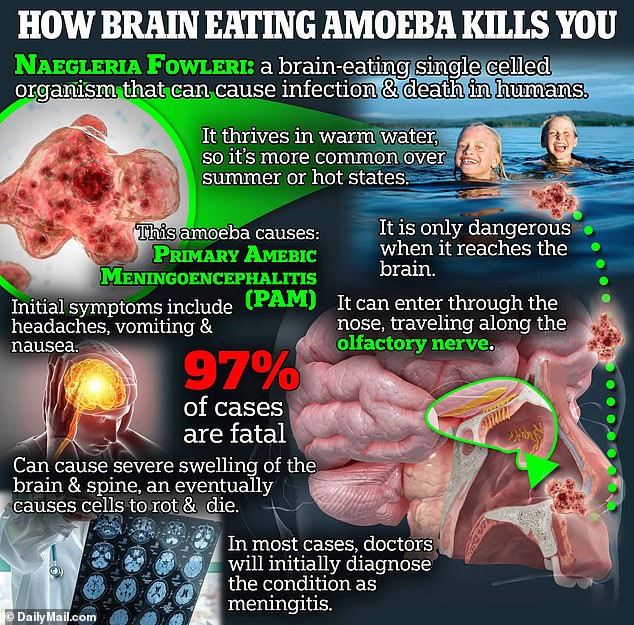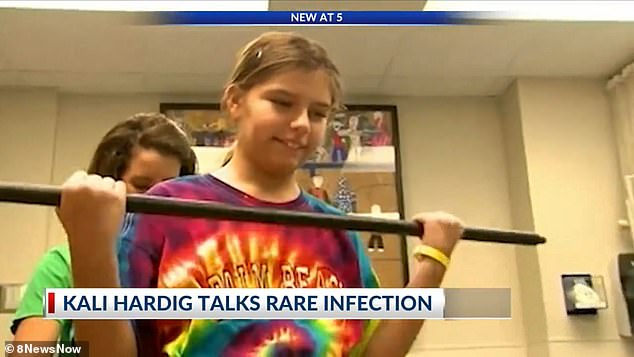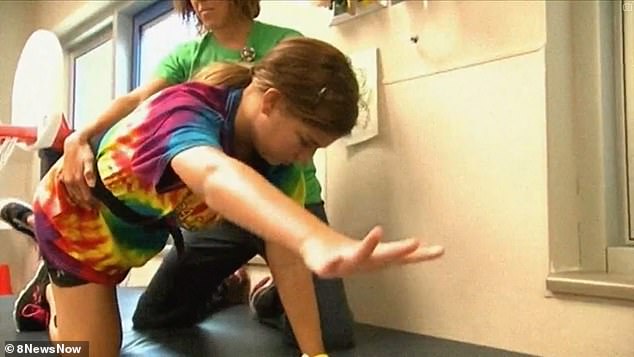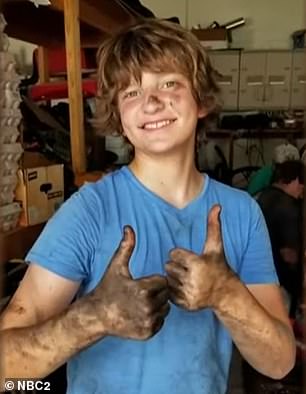‘They told me it was a death sentence’: Only four Americans have ever survived after being infected with brain-eating amoeba – these are the stories of two of those victims
Only four people in the US have ever caught a deadly brain-eating amoeba that claimed the life of a toddler last week and lived to tell the tale.
Kali Hardig, now 22, a native of Arkansas, was just 12 years old when she was struck by Naegleria fowleri, which doctors believe she contracted at a water park.
They told her it was a ‘death sentence’ and gave her just four days to live, but ten years later she is swimming again and became a mother for the first time last November. She only occasionally experiences blurred vision in her left eye due to scar tissue from the disease.
Fourteen-year-old Caleb Ziegelbauer from Florida is also now a year removed from being infected with the microscopic strain that kills 97 percent of victims.
Caleb now walks a little, but the damage to his brain requires him to communicate with facial expressions and requires the use of a wheelchair.
Kali Hardig, 22, survived her infection with the brain-eating amoeba ten years ago. She became a mother last November and her daughter Adalynn (shown with Kali) was now 10 months old. She also still has occasional blurred vision in her left eye

Caleb Ziegelbauer, 14, became infected with the amoeba about a year ago after swimming in an estuary. He can now stand, walk and talk somewhat, although he still requires a wheelchair

Official data shows that between 1962 and 2022, 157 people in the US were infected with the disease, of which only four survived.
Five deaths from the amoeba have been reported this year, the latest being a one-year-old toddler from Arkansas who died on September 4.
There are fears that global warming will warm freshwater pools across the country, putting more people at risk from the amoeba.
Among the few lucky survivors is Ms Hardig, who became infected with the deadly amoeba in 2013, when she was just 12 years old, after swimming at the Willow Springs Water Park near her home.
“They called it a death sentence,” she said KARK, describes the moment she was diagnosed.
“They told my parents by Sunday that I would be gone because it goes that fast.”
But after undergoing surgery to deliver drugs directly to her brain and the anti-amoebic drug miltefosine from Germany, she made a remarkable recovery.
Ten years after the infection, she said the only effect she still suffers from is occasional blurred vision in her left eye.
“It causes me to have blurry vision every now and then, but that’s about the only long-lasting effect I get from it,” she said.
Doctors said she also had scarring on her brain, but added that this should not affect her abilities.
Her father Joseph told her WHY in 2016: ‘The doctor said, ‘She has some scarring on her brain, but imagine your brain as a fuse box. Your core of your brain is your fuse box, and the fuse box extends to the rest of your body. Brains are like electrical sockets. Some of her electrical outlets have some damage, but her fuse box is fine. The brain will redirect and bypass these.”
She has since moved to Oblong, Illinois, where she works as a receptionist at security company Allied Universal.
Last November, she welcomed her daughter Adalynn Hardig into the world.

Ms Hardig said that after the infection she was like a ‘brand new baby’ and had to learn everything all over again, including walking, talking, reading and writing

She is pictured above undergoing rehabilitation to regain her skills. A year after the infection, she was able to swim again
Ms Hardig suffered from constant pounding headaches for days after she went swimming in a pond near her home in 2013.
Her mother initially thought she was dehydrated and doctors thought it was a severe case of flu, but tests soon revealed she had an amoeba in her body.
She was kept in hospital for 55 days and, after fighting the infection, said she was like a “brand new baby” having to learn to walk, talk, write and read again.
A year after her ordeal, she said she was still afraid to touch water, even when in the shower.
‘“I was afraid to shower because I know I get it from water, and I thought it could come from all kinds of water, that it could come in the shower,” she said.

He contracted the disease after going swimming with his family at Port Charlotte Beach on July 1, 2022
But in August 2014, about a year after the infection, she overcame her fear to start swimming again.
Of the moment in 2016, she said, “They let me swim in the pool at Children’s one time and I knew I wouldn’t get sick.
‘I was ecstatic because I knew I could still swim. And I like swimming.’
People become infected with the amoeba after swimming in warm freshwater bodies, such as lakes, where the amoeba thrives.
The infection starts in the nose before traveling to the brain via the olfactory nerve.
In the early stages, patients suffer from symptoms such as splitting headaches, high fever, change in taste or smell and sensitivity to light. But this quickly evolves into hallucinations and seizures, killing most victims within days.
Another survivor is Caleb Ziegelbauer, 14, of Florida, who is now just over a year post-infection on July 1, 2022.
After the infection, Mr. Ziegelbauer had to learn to stand up, walk and talk again, just like Ms. Hardig.
In his last interview in July this year, he was able to stand up, laugh and talk a little – but still had to use a wheelchair and sometimes use facial expressions to communicate.
He said, “I’ve come this far and yet I’ve made a lot of progress.”
He added, “I can talk with my eyebrow.”

Caleb returned from intensive rehabilitation in March, meaning he can now stand, smile and communicate, although his speech is impaired
Like Ms Hardig, his family were also told they had only four days left with him after the deadly amoeba was diagnosed. Doctors now say they have never been happier when they were wrong.
His symptoms started as a severe headache and fever after he visited Charlotte Beach, at the mouth between the freshwater Peace River and the saltwater Gulf of Mexico.
But they then developed into hallucinations, prompting his family to rush him to the hospital, along with his mother Jesse, who said his condition “deteriorated rapidly” during the hour-long car ride.
Doctors at Golisano Children’s Hospital, Fort Myers, placed him in a coma and administered medications for treatment.
His mother Jesse added, “He told me (Caleb) he heard me talking to him and Caleb said if you can hear me coming back.
“I promised that as soon as he runs, we want to do the 5K at Disney.”
Mr. Ziegelbauer also wants to become an epidemiologist.
He added: ‘I wanted to find the cure for Covid, but now I’m going to find the vaccine for Naegleria fowleri.’
Patients who catch the amoeba and survive have to learn everything all over again like a brand new baby because of the damage to their brain and nervous system.
During infection, the amoeba causes inflammation and the destruction of brain tissue, affecting areas of the brain, including those responsible for speech and language.
Doctors suggest that both patients’ survival was due to a combination of early diagnosis, the treatments they received and luck.
Ms Hardig was given the drug miltefosine – which is not routinely used against Naegleria fowleri – to treat her infection.
In Caleb’s case, doctors started treating him for the amoeba seven days after he started swimming — which may have been early enough to prevent the infection.
Doctors say the disease is becoming more common thanks to global warming caused by global warming.
Dr. Dennis Kyle, head of cell biology at the University of Georgia, previously told FOX8: ‘We are experiencing warmer temperatures and these amoebae are thermally tolerant… so the number of amoebae will be higher.
“A warmer climate means, yes, more exposure and more cases.”
There are also concerns about Vibrio vulnificus, a dangerous bacteria that lives in warm seawater and can cause fatal infections.
Experts also warn that infections with this are becoming more common thanks to warming seawater.
